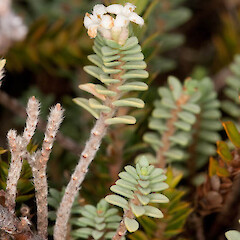Pimelea urvilleana subsp. nesica
Common name
pinātoro
Synonyms
Pimelea urvilliana subsp. nesica C.J.Burrows orth. var.
Family
Thymelaeaceae
Flora category
Vascular – Native
Endemic taxon
Yes
Endemic genus
No
Endemic family
No
Structural class
Trees & Shrubs - Dicotyledons
Current conservation status
The conservation status of all known New Zealand vascular plant taxa at the rank of species and below were reassessed in 2017 using the New Zealand Threat Classification System (NZTCS) – more information about this can be found on the NZTCS website. This report includes a statistical summary and brief notes on changes since 2012 and replaces all previous NZTCS lists for vascular plants.
Please note, threat classifications are often suggested by authors when publications fall between NZTCS assessment periods – an interim threat classification status has not been assessed by the NZTCS panel.
- Conservation status of New Zealand indigenous vascular plants, 2017 . 2018. Peter J. de Lange, Jeremy R. Rolfe, John W. Barkla, Shannel P. Courtney, Paul D. Champion, Leon R. Perrie, Sarah M. Beadel, Kerry A. Ford, Ilse Breitwieser, Ines Schönberger, Rowan Hindmarsh-Walls, Peter B. Heenan and Kate Ladley. Department of Conservation. Source: NZTCS and licensed by DOC for reuse under the Creative Commons Attribution 4.0 International licence.
2017 | Data Deficient
Previous conservation statuses
2012 | Not Threatened
2009 | Not Threatened
2004 | Not Threatened
Brief description
Very low-growing sprawling shrub with white-hairy twigs bearing clustered pairs of narrow blue-green leaves, hairy white flowers and white fruit inhabiting coastal northern North Island south to the Coromandel Peninsula. Leaves 5-8mm long by 2-3.5mm, underside shiny.
Distribution
Endemic. North Island: West Auckland Coastline, Hauraki Gulf Islands, Great Barrier, Cuvier, Mercury, Alderman, Mayor, and eastern Coromandel Peninsula offshore islands, near Whangaparaoa (eastern Bay of Plenty).
Habitat
Mainly on offshore islands, near shore rock stacks and coastal rock outcrops, cliffs, banks, sandy areas, and occasionally in scrub. Favouring sites exposed to salt spray and sometimes on soil enriched by bird excreta.
Detailed description
A small to medium-sized prostrate to decumbent shrub with long, often trailing, flexible branches (to 400 mm). Young stems moderately densely covered in white, appressed hair. Branching sympodial and lateral. Internodes up to 3 mm long. Node buttresses short, lunate, black, shining, masked by hair on youngest stems. Old stems glabrate, grey-brown. Leaves ascendant near branchlet tips, then patent to deflexed, often apparently distichous and relatively distant, on short (0.2 mm) sometimes red petioles or sessile. Lamina pale to medium green, glaucous, moderately thin, elliptic, ovate or sometimes oblong, 5–8 × 2–3.5 mm, flat, or slightly adaxially concave, margin thickened, slightly upturned, acute but often blunt-tipped, midvein obscure abaxially. Stomata abundant on adaxial side, none or very few on abaxial side. Abaxial surface glistens. Inflorescences terminal on branchlets, 4–6-flowered. Involucral bracts 4, about the same size as adjacent leaves. Plants gynodioecious. Flowers white, densely hairy outside, inside some hair near top of ovary portion. Female tube 3 mm long, ovary portion 2.5 mm, calyx lobes 1.5 × 0.9 mm; hermaphrodite tube 4.2 mm long, ovary portion 3 mm, calyx lobes 2 × 1.5 mm. Anther dehiscence semi-latrorse. Ovary densely hairy at summit. Fruits subglobose, fleshy, white, opaque, 5 × 4 mm. Seeds ovoid, 2.7 × 1.6 mm.
Similar taxa
Pimelea urvilleana is allied to and difficult to distinguish from P. prostrata, a species complex with which it shares a similar prostrate to decumbent growth habit. It differs from that species complex by the leaves which are stiff to flexible, elliptic or ovate; and which have stomata visible only on the adaxial leaf surfaces, and by the young stem internodes which are densely covered in bright white hairs. Pimelea urvilleana subsp. urvilleana differs from subsp. nesica by the somewhat shorter and thicker rather than longer and thinner leaves, which are 3–6 mm cf. 5–8 mm long, narrow-elliptic to ovate, rather than elliptic, ovate or oblong, and flat or slightly keeled rather than flat to adaxially concave. The leaf- tip of subsp. urvilleana is obtuse while that of subsp. nesica is acute (though blunt-pointed). The branchlets of subsp. urvilleana are more densely covered in hairs. These differences seem minor and further study is needed to ascertain the validity of accepting the two subspecies
Flowering
September - April
Flower colours
White
Fruiting
October - June
Propagation technique
Easily grown from semi-hardwood cuttings and rooted pieces. Seed is difficult to germinate. Best grown in a well drained soil in full sun. An excellent plant for the rockery
Threats
Probably not threatened but until the exact circumscription of this new subspecies is understood as a precautionary measure it is probably best treated as Data Deficient
Etymology
pimelea: Pimeleoides means “resembling Pimelea’’, a genus in the family Thymelaeaceae (Greek, -oides = resembling, like).
urvilleana: After D’Urville Island, which is named in honour of Jules Sébastien César Dumont d’Urville (23 May 1790 - 8 May 1842) - a French explorer, naval officer and rear admiral, who explored the south and western Pacific, Australia, New Zealand and Antarctica.
Where To Buy
Probably commericially available.
Attribution
Fact sheet prepared by P.J. de Lange (17 October 2009). Description adapted from Burrows (2009).
References and further reading
NZPCN Fact Sheet citation
Please cite as: de Lange, P.J. (Year at time of access): Pimelea urvilleana subsp. nesica Fact Sheet (content continuously updated). New Zealand Plant Conservation Network. https://www.nzpcn.org.nz/flora/species/pimelea-urvilleana-subsp-nesica/ (Date website was queried)

